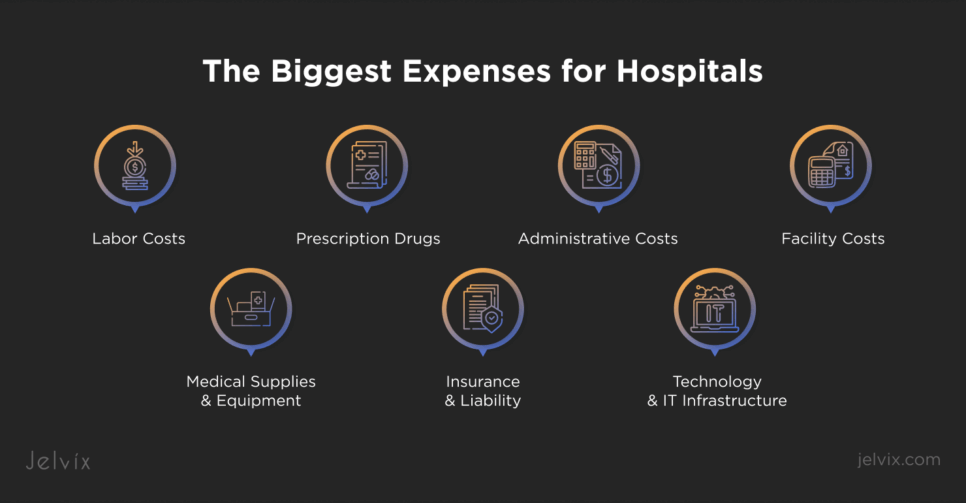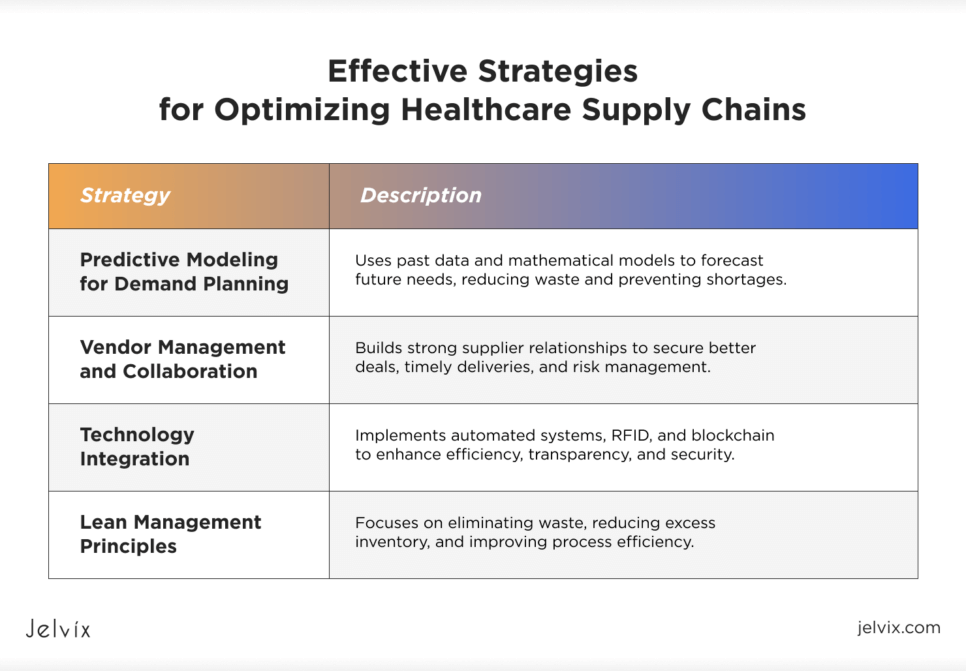Healthcare costs have been rising steadily over the years, often faster than prices in the general economy. Between March 2023 and 2024 only, medical care prices increased by 2.2%, with costs for hospital services leading the way.
A big part of the problem is that many clinics manage resources inefficiently and use outdated systems to manage increased workloads. This leads to wasted resources and higher operational expenses, putting extra pressure on medical facilities.
If you want to improve cost management at your clinic using technology, keep reading. In this article, you’ll learn about the main factors that affect healthcare costs, why it’s important to manage your supply chain efficiently, and how digital tools can help cut operational costs at your clinic.
Current Trends in Healthcare Costs You Need To Know
Health spending in the U.S. surged by 4.1% in 2022, reaching USD4.5 trillion, or USD13,493 per person.
One of the key reasons for medical costs to grow is the rise of chronic diseases, such as diabetes, heart disease, and cancer. These long-term conditions require continuous attention and intervention which adds to the expenses.
The aging population makes things worse. Older patients are more prone to diseases and usually require extensive and continuous medical care.
Finally, clinics face a cost surge because of complicated healthcare billing and insurance systems. Since providers need to deal with various insurance requirements, coding systems, and reimbursement processes, administrative expenses become bigger.
The Biggest Expenses for Hospitals: Why They Keep Losing Money
Hospitals have to deal with a lot of costs to make sure they can provide really good healthcare. Understanding expenses can help you handle your finances better.
Labor Costs
Labor costs cover the pay and benefits for doctors, nurses, technicians, and the admin staff. When there isn’t enough staff, existing pros have to work overtime or clinics have to hire temporary workers, which boosts labor expenses.
Medical Supplies and Equipment
Day-to-day medical procedures require a constant supply of consumables like gloves, syringes, bandages, and surgical instruments, which adds to ongoing expenses. Clinics also need to invest in advanced medical technology, such as MRI machines and CT scanners, that come with high acquisition and maintenance costs.
Prescription Drugs
Hospitals have to spend a lot of money on inpatient drugs, especially on specialty medications and those used in critical care. They also have to cover the cost of medications for outpatient treatments, which adds to their overall pharmaceutical expenses.
Administrative Costs
Managing billing and coding for insurance claims, patient payments, and reimbursements involves significant administrative work, specialized staff, and sophisticated software, which adds to the costs. What’s more, ensuring adherence to regulations like HIPAA involves administrative costs related to documentation, reporting, and staff training.
Facility Costs
Operating and maintaining hospital facilities entails costs for utilities (electricity, water, heating), cleaning, and general upkeep. Constructing new facilities or renovating existing ones to meet modern standards and expand capacity also incurs substantial financial outlays.
Technology and IT Infrastructure
EHR optimization and maintenance involves significant costs, including software licensing, hardware, and ongoing technical support. Protecting sensitive patient data from cyber threats requires substantial investment in robust cybersecurity measures and regular system updates.
Explore how CRM-EHR integration enhances patient care and operational efficiency by uniting patient data and streamlining healthcare workflows.
Insurance and Liability
Hospitals pay for malpractice insurance to shield against legal claims and lawsuits. Premiums for this insurance can be quite high, especially in high-risk medical specialties. Insuring hospital buildings, equipment, and other assets against damage or loss adds to the financial burden.ооо
The Importance of a Healthcare Supply Chain for Cost-Efficiency
The supply chain in healthcare is the foundation of cost-effectiveness. Without an efficient system, hospitals can face spiraling costs, supply bottlenecks, and, ultimately, compromised patient care.
Key Strategies for Supply Chain Optimization
Optimizing the supply chain in healthcare involves using smart strategies to make things run smoother, cut down on waste, and improve how materials and data move around.
Predictive Modeling for Demand Planning
Predictive modeling involves using past data and math to predict how many medical items and meds hospitals will need in the future. This helps hospitals make sure they have enough supplies without hoarding too much. It also cuts down on wasted products and stops any shortages that could mess up patient care.
Vendor Management and Collaboration
It’s really important to have good relationships with your suppliers to make sure your supply chain is strong. Working together helps healthcare facilities get better deals, ensure they get what they need on time, and make sure the supply chain meets the needs of the patients. Managing vendors well means keeping an eye on how well they’re doing and making sure you have different options to reduce risks.
Technology Integration
Using modern tech like automated inventory systems, RFID tracking, and blockchain can really speed up how supply chains work. Automated systems cut down on manual checks and keep an eye on supplies in real time. Plus, RFID and blockchain make everything transparent and traceable, which prevents fraud and theft.
Lean Management Principles
Lean management focuses on identifying and eliminating waste within the supply chain. This approach streamlines processes, reduces excess inventory, and boosts workflow efficiency, creating an agile and responsive supply chain capable of adapting to changing demands.
The Most Worrying Challenges in Healthcare Inventory Management
Managing inventory in hospitals is an important task that requires precision and foresight. When things go wrong, it can spell disaster for both the clinic and its patients. By addressing key challenges, you can optimize your inventory processes and reduce associated costs.
Overstocking and Stockouts
It’s often difficult for hospitals to keep the balance between overstocking and stockouts. Overstocking can drain your budget and fill your storage spaces with unnecessary items. On the other hand, stockouts can be even more dangerous as a lack of necessary supplies can lead to critical outcomes in patient care. Consider implementing accurate demand forecasting and robust inventory management practices to avoid these pitfalls.
Expired Inventory
Expired inventory isn’t just a financial headache, but a potential danger to patients. Medications and medical supplies that go past their expiration dates can be costly mistakes. Implement effective tracking systems and regular inventory audits to ensure that expired items are promptly removed from stock. This will help safeguard patient health and reduce waste.
How Does Telemedicine Reduce Costs for Clinics and Patients?
Some see telemedicine as a tool to provide more services. However, it changes healthcare allowing clinics to reach out to patients faster, slashing costs for them, providers, and the entire medical system.
Expanding Access to Care
Telemedicine tears down geographic barriers, allowing patients in remote locations to get medical advice and primary care without the need to travel long distances. Underserved areas can greatly benefit from this possibility, ensuring timely, appropriate, and cost-efficient medical intervention.
Reducing In-Person Visit Costs
Telemedicine appointments are usually less expensive than traditional in-person visits. This is especially important for people who deal with chronic conditions and require frequent consultations.
Remote Patient Monitoring
Remote patient monitoring is another medical advancement that often accompanies telehealth services. RPM devices allow doctors to track patients’ health data in real time, leading to early detection of potential health issues and reducing the need for emergency interventions and hospital admissions. RPM empowers patients to manage their health better, improving outcomes while cutting overall healthcare costs.
Lowering Staffing Costs with the Help of Modern Tech and Education
In healthcare, managing staffing costs is essential for financial health. Using modern technology and improving education can help reduce these costs while still providing excellent patient care.
Using Technology To Support Staff Efficiency
New scheduling software can make staff shifts more efficient, reducing the need for overtime and preventing burnout. Automated tools handle routine tasks like patient check-ins and billing, so staff can focus more on caring for patients.
Education Employment Platform
Education employment platforms connect hospitals with skilled workers faster and provide training to keep staff up-to-date on the latest medical practices. This reduces the time and cost of hiring new employees.
Reducing Staff Turnover
High staff turnover can drain healthcare finances due to the constant cycle of recruiting, hiring, and training new employees. Modern tech can boost job satisfaction by reducing workloads and stress levels.
Moving Towards Digital Hospitals with Robotic Automation
Robotic process automation in healthcare is a growing trend, with its market expected to hit USD2,081.9 million by 2030. That’s because machines can perform tasks traditionally requiring human intervention with better efficiency. Robots help optimize workflows, reduce errors, and minimize operational costs in operations management.
Robotics in Healthcare: Real-World Cases To Learn from
Real-world cases of implementing and using RPA in healthcare can help you understand what exactly you need to automate and how to do it with the best efficiency.
Precision and Efficiency in Surgeries
Mayo Clinic has integrated robotic systems for various tasks, including surgeries and patient transport. They use the da Vinci Surgical System for minimally invasive procedures, which has significantly reduced recovery times and improved surgical outcomes.
Reducing Manual Work
King’s Facility Management used RPA to optimize payroll and HR tasks. Handling over 4,500 employee records, the introduction of RPA reduced the processing time from over 100 days of manual effort to just two weeks.
Saving Time for the Staff
Helse Vest is a major health trust in Norway that implemented RPA to automate administrative tasks. As a result, they managed to save over 14,000 hours annually. This time savings allowed healthcare professionals to devote more attention to patient care, leading to faster patient processing times and shorter waiting periods.
Discover the factors driving healthcare app development costs, from design to security, to help you budget effectively.
Core Benefits of Cloud Electronic Health Records for Hospitals
Cloud-based EHRs can significantly enhance the efficiency, accessibility, and quality of care at your clinic. Along with numerous benefits, they support interoperability which makes the connection of various systems and devices easier to manage.
Cost Efficiency
Cloud-based EHRs reduce the need for expensive hardware and IT maintenance. Clinics and hospitals can avoid upfront costs for servers and data centers by paying for a subscription service that scales with their needs.
Accessibility
With cloud-based EHRs, healthcare providers can access patient records from anywhere at any time, provided they have an internet connection. This flexibility is especially useful for telemedicine services and for doctors who work at multiple locations.
Scalability
As a practice grows, its data storage needs increase. Cloud-based systems can easily scale up to accommodate more data without significant disruptions or additional investments in physical infrastructure.
Elasticity
Cloud-based EHR systems are flexible and can easily adapt to the changing workloads. The cloud’s elasticity ensures that your clinic uses resources efficiently, controlling all the costs and performing well.
Automatic Updates
Cloud service providers handle software updates and security patches, ensuring the EHR system is always up-to-date with the latest features and security protocols.
Disaster Recovery
Cloud-based EHRs include robust backup and disaster recovery solutions. Patient data is safely stored in multiple locations, protecting it from loss due to hardware failures, natural disasters, or cyberattacks.
Interoperability and Data Sharing
One of the key benefits of interoperability for cloud-based EHRs is the ability to share patient data seamlessly across different systems. With interoperable EHRs, doctors can easily access patients’ medical histories, ensuring continuity of care and data integrity.
How Jelvix’s Solutions Can Help with Inventory Management in Hospitals
Clinics need to keep track of supplies to make sure they have what they need without overstocking or running out. At Jelvix, we offer advanced digital solutions to optimize inventory management and reduce operational costs.
Our inventory tracking systems give you real-time updates on what you have, where it is, and how it’s being used. This way, you can keep everything at the right levels. We also develop and put into action automatic reordering systems to take the hassle out of restocking. These systems keep an eye on stock levels and request reordering for more supplies as soon as they start running low.
If you need help developing or implementing digital solutions for inventory management, contact us—our expert team is here to assist.
Looking for expert developers?
Achieve your business goals with a dedicated team of skilled professionals.














